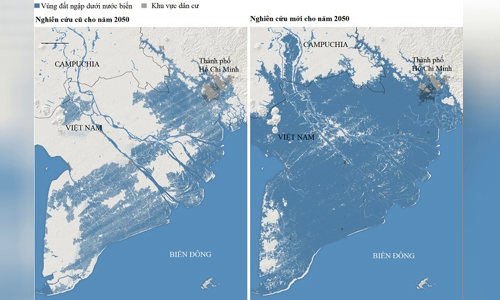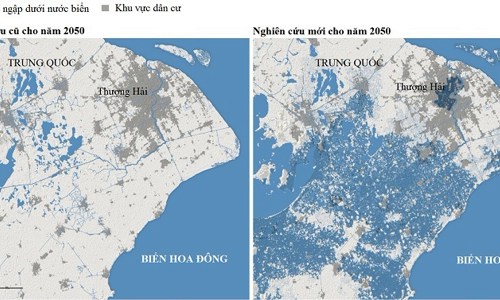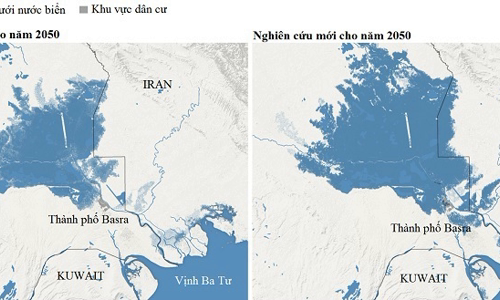Southern Vietnam, including Ho Chi Minh City, with a population of 20 million may be submerged in sea water by 2050, according to Climate Central research.
Climate Central, a science organization based in New Jersey, USA, on October 29 published a new study in Nature Communications, showing that the number of people affected by rising sea levels will triple. 2050 compared to previous forecasts, threatening to eradicate almost all major coastal cities in the world.

Southern Vietnam may disappear due to sea level rise Photo: New York Times
The authors of the study developed a way to calculate elevation of the ground based on satellite data, a standard estimation of the impact of sea level rise. The results suggest that sea levels will rise higher in large areas and that previous forecasts are too optimistic. According to the new study, about 150 million people will live in underwater areas by the middle of this century. In particular, southern Vietnam may almost disappear.
The first map shows previous predictions of the flooded area by 2050. However, the second map based on new research indicates that the bottom of the country will be submerged under sea. More than 20 million Vietnamese, accounting for nearly a quarter of the population, live on lands that will be flooded during high tide.
Wetlands in southern Vietnam in 2050 in the old and new forecasts. Graphics: New York Times.
Much of Ho Chi Minh City, the country's economic center, will disappear. Projections do not take into account future population growth or land loss due to coastal erosion.
Scott A. Kulp, a researcher at Climate Central, one of the authors of the study, said that satellite altitude measurements had a little difficulty distinguishing real ground from tree tops or buildings. . So he and Benjamin Strauss, CEO of Climate Central, used artificial intelligence to identify error rates and correct errors.
In Thailand, more than 10% of the people currently live on potentially flooded areas by 2050, while the previous forecast was only 1%. The political and commercial capital of Bangkok is especially in an alarming state.

Wetlands in Shanghai in 2050 in the old forecast and the new forecast Photo: New York Times
Loretta Hieber Girardet, a Bangkok resident and a United Nations disaster risk reduction official, said climate change would put pressure on cities in many ways. As global warming takes place in more places, it will also push poor farmers to leave their homes to find jobs in cities. "This is a terrible recipe," she said.
In Shanghai, one of Asia's most important economic apparatuses, rising sea levels threaten to destroy the city center and many surrounding cities.
Wetlands in Shanghai in 2050 in the old forecast and the new forecast. Graphics: New York Times.
The findings do not signal an outcome for those areas. New data shows that 110 million people around the world lived below the water at high tide. According to Mr. Strauss, they have not been greatly affected by protection measures such as breakwaters and other barriers.
However, even with investments, safeguards can only be up to a point. Strauss gave the example of New Orleans, a city below sea level devastated in 2005 when extensive dikes and other protective measures failed during Hurricane Katrina. "How deep do we want to live in a bowl?" He asked.
New forecasts show that much of Mumbai, India's financial capital and one of the world's largest cities, is in danger of being wiped out. Built on a series of islands, the city's historic commercial center is particularly vulnerable.

Wetlands in the sea in Basra in 2050 in the old forecast and the new forecast Photo: New York Times
According to a study by Dina Ionesco of the International Organization for Migration, an intergovernmental group that coordinates action on migrants and development, the study suggests that countries should start preparing now for migrants. moving into inland areas. "We tried to ring the alarm. We knew it was coming. We had some modern precedents for this migration," Ionesco said.
The encroachment of seawater can also destroy cultural heritage. The port city of Alexandria in Egypt founded by Alexander the Great around 330 BC is at risk of being submerged by seawater.
Elsewhere, migration due to rising sea levels can cause or worsen regional conflicts. Much of Basra, the second largest city in Iraq, could be underwater by 2050. If that happens, the impact will go beyond the Iraqi border, according to John Castellaw, retired lieutenant general of the marines. The US, the chief of staff of the US Central Command in the Iraq War, said.
Wetlands in the sea in Basra in 2050 in the old forecast and the new forecast. Graphics: New York Times.
"The loss of land due to rising water will threaten to promote political and social instability in the region, leading to the possibility of re-conflict of arms and the risk of terrorism," Castellaw, now with the Center's advisory board, said. Climate and Security, a research and advocacy group in Washington, said. "So this is not simply an environmental issue, but a humanitarian, security and possibly military issue."



 SajidShah
SajidShah







